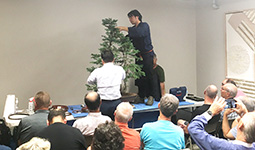February 2022
- PREVIOUS
- NEXT
Communicating the Wonders of Bonsai Abroad

A bonsai created by Mori 
Mori Takahiro prunes a bonsai in a demonstration at the Japan Information & Culture Center, Embassy of Japan, Washington D.C.

Mori gives a presentation to people of all ages at Japan House, Los Angeles 
Mori and participants at a bonsai workshop in Gardens by the Bay, Singapore 
Mori at work on a Japanese cedar bonsai in a demonstration at the Nikkei National Museum & Cultural Centre, Burnaby, Canada

From July to September 2019, Bonsai Master Mori Takahiro toured eight cities in four countries—Canada, the United States, Australia and Singapore—as a Japan Cultural Envoy. Here, Mori shares his experiences meeting attendees to his lectures and workshops on bonsai in each of these countries.

Bonsai are planted in pots*, shaped to resemble the forms of the trees in their natural environment, and appreciated for their beauty. Bonsai have been loved by the Japanese for more than a thousand years. Today, there are even museums entirely dedicated to bonsai. Since the 1990s, the community of bonsai enthusiasts has grown around the world.
Mori Takahiro says the joy of bonsai is its “compact beauty.” “One creates and squeezes a small world into a pot just as if the tree had grown there naturally. What is so interesting about bonsai is that despite the small size, it is possible to create the appearance of a majestic tree by trimming the leaves and arranging the shape of the trunk and branches.”
Many who work with bonsai inherit their family business, but this was not the case with Mori, who aspired to the path of bonsai after graduating from university. One of the main reasons for his interest was wanting to learn about Japan’s unique culture and make use of his knowledge overseas. After training for about five years, Mori became a bonsai master. Not long after, he produced a work which won the Kokufu Award, the top honor at the prestigious Kokufu Bonsai Exhibition organized by the Nippon Bonsai Association. Now recognized as a bonsai master, Mori started to promote bonsai abroad as had been his initial ambition. Before the COVID-19 pandemic, he was involved with promoting bonsai in California where he held workshops every spring.

Mori was appointed Japan Cultural Envoy for bonsai from July to September 2019. As a Cultural Envoy, Mori visited eight cities in four countries: Canada, the United States, Australia and Singapore. In his lectures, Mori introduced the basics of bonsai, including demonstrations of trimming and methods of expression. The participants were astonished to hear that some bonsai in Japan have an estimated age of more than a thousand years. Responding to the astonishment, Mori explained that a bonsai can be passed down for generations if the tree is given love and kept healthy by watering and repotting at the right time so that it firmly takes root. In demonstrations using local trees and materials, Mori showed techniques to adjust the shape of a tree by pruning and using wires in such a way as to allow the bonsai to look large and vigorous when half of the branches are trimmed and most of the leaves removed. Mori comments, “Everyone who saw my performance seemed to have a much better understanding of bonsai.” Participants also brought their own bonsai to workshops, received advice from Mori, and trimmed their trees.
When a bonsai master prunes a tree, it looks effortless, as if anyone could easily do it, but even if you have a clear image of the finished tree and use the pruning scissors carefully, the result won’t always correspond to what you had in mind. In this respect, bonsai is profound.

Mori says, “Nature is actually bonsai’s best teacher—natural forms such as a pine tree that has weathered wind and snow, or a persimmon tree heavy with fruit provide the models. This is why many people in bonsai communities talk about ‘learning from nature.’ Through bonsai, I would like to demonstrate to the world Japan’s appreciation of nature underpinning the art of shaping trees.”
Mori mentions his discoveries as a Cultural Envoy. In Japan, bonsai are usually grown outdoors, but on his visit to Singapore, he found that some people were using LED lights to grow bonsai indoors. This was eye-opening, he says.

“I was intrigued to learn how bonsai can be grown using red and blue LED lighting. With this method, it might be possible to enjoy bonsai in environments that have been unsuitable in the past, such as extremely cold areas or deserts. I felt that the potential for bonsai has significantly broadened.”
As well as using his experience as a Japan Cultural Envoy and helping more people around the world enjoy bonsai, Mori is eager to continue presenting to the world the wonders of bonsai.
* Pots for Bonsai “Bonki”: Please refer to Highlighting Japan 152, January 2021.
- PREVIOUS
- NEXT

